Capital Budgeting Techniques: Cash Flow and Risk Assessment
VerifiedAdded on 2023/06/03
|8
|2724
|309
Report
AI Summary
This report provides a detailed analysis of capital budgeting techniques, including Net Present Value (NPV), Internal Rate of Return (IRR), payback period, and Accounting Rate of Return (ARR). It discusses the advantages and disadvantages of each technique, emphasizing the importance of accurate cash flow estimation and risk analysis. Key factors for cash flow determination, such as incremental cash flows, sunk costs, opportunity costs, synergistic effects, and working capital changes, are examined. The report also explores risk analysis tools like sensitivity analysis and scenario analysis, highlighting the use of real options for risk management. The conclusion underscores the significance of capital budgeting techniques in project financial feasibility analysis and the need for careful consideration of cash flows and risk factors.

BUSINESS FINANCE
Capital Budgeting
STUDENT ID:
[Pick the date]
Capital Budgeting
STUDENT ID:
[Pick the date]
Paraphrase This Document
Need a fresh take? Get an instant paraphrase of this document with our AI Paraphraser
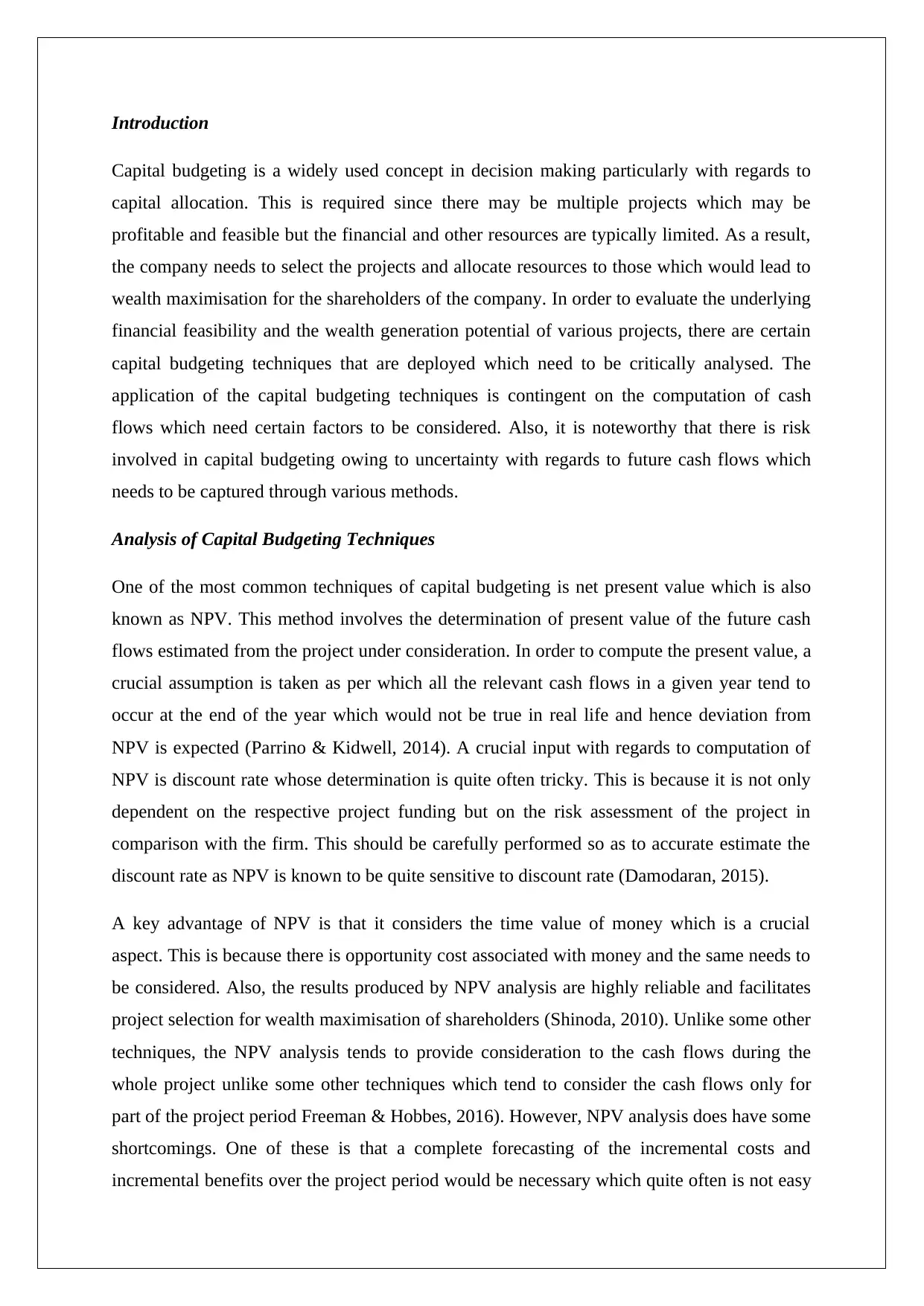
Introduction
Capital budgeting is a widely used concept in decision making particularly with regards to
capital allocation. This is required since there may be multiple projects which may be
profitable and feasible but the financial and other resources are typically limited. As a result,
the company needs to select the projects and allocate resources to those which would lead to
wealth maximisation for the shareholders of the company. In order to evaluate the underlying
financial feasibility and the wealth generation potential of various projects, there are certain
capital budgeting techniques that are deployed which need to be critically analysed. The
application of the capital budgeting techniques is contingent on the computation of cash
flows which need certain factors to be considered. Also, it is noteworthy that there is risk
involved in capital budgeting owing to uncertainty with regards to future cash flows which
needs to be captured through various methods.
Analysis of Capital Budgeting Techniques
One of the most common techniques of capital budgeting is net present value which is also
known as NPV. This method involves the determination of present value of the future cash
flows estimated from the project under consideration. In order to compute the present value, a
crucial assumption is taken as per which all the relevant cash flows in a given year tend to
occur at the end of the year which would not be true in real life and hence deviation from
NPV is expected (Parrino & Kidwell, 2014). A crucial input with regards to computation of
NPV is discount rate whose determination is quite often tricky. This is because it is not only
dependent on the respective project funding but on the risk assessment of the project in
comparison with the firm. This should be carefully performed so as to accurate estimate the
discount rate as NPV is known to be quite sensitive to discount rate (Damodaran, 2015).
A key advantage of NPV is that it considers the time value of money which is a crucial
aspect. This is because there is opportunity cost associated with money and the same needs to
be considered. Also, the results produced by NPV analysis are highly reliable and facilitates
project selection for wealth maximisation of shareholders (Shinoda, 2010). Unlike some other
techniques, the NPV analysis tends to provide consideration to the cash flows during the
whole project unlike some other techniques which tend to consider the cash flows only for
part of the project period Freeman & Hobbes, 2016). However, NPV analysis does have some
shortcomings. One of these is that a complete forecasting of the incremental costs and
incremental benefits over the project period would be necessary which quite often is not easy
Capital budgeting is a widely used concept in decision making particularly with regards to
capital allocation. This is required since there may be multiple projects which may be
profitable and feasible but the financial and other resources are typically limited. As a result,
the company needs to select the projects and allocate resources to those which would lead to
wealth maximisation for the shareholders of the company. In order to evaluate the underlying
financial feasibility and the wealth generation potential of various projects, there are certain
capital budgeting techniques that are deployed which need to be critically analysed. The
application of the capital budgeting techniques is contingent on the computation of cash
flows which need certain factors to be considered. Also, it is noteworthy that there is risk
involved in capital budgeting owing to uncertainty with regards to future cash flows which
needs to be captured through various methods.
Analysis of Capital Budgeting Techniques
One of the most common techniques of capital budgeting is net present value which is also
known as NPV. This method involves the determination of present value of the future cash
flows estimated from the project under consideration. In order to compute the present value, a
crucial assumption is taken as per which all the relevant cash flows in a given year tend to
occur at the end of the year which would not be true in real life and hence deviation from
NPV is expected (Parrino & Kidwell, 2014). A crucial input with regards to computation of
NPV is discount rate whose determination is quite often tricky. This is because it is not only
dependent on the respective project funding but on the risk assessment of the project in
comparison with the firm. This should be carefully performed so as to accurate estimate the
discount rate as NPV is known to be quite sensitive to discount rate (Damodaran, 2015).
A key advantage of NPV is that it considers the time value of money which is a crucial
aspect. This is because there is opportunity cost associated with money and the same needs to
be considered. Also, the results produced by NPV analysis are highly reliable and facilitates
project selection for wealth maximisation of shareholders (Shinoda, 2010). Unlike some other
techniques, the NPV analysis tends to provide consideration to the cash flows during the
whole project unlike some other techniques which tend to consider the cash flows only for
part of the project period Freeman & Hobbes, 2016). However, NPV analysis does have some
shortcomings. One of these is that a complete forecasting of the incremental costs and
incremental benefits over the project period would be necessary which quite often is not easy
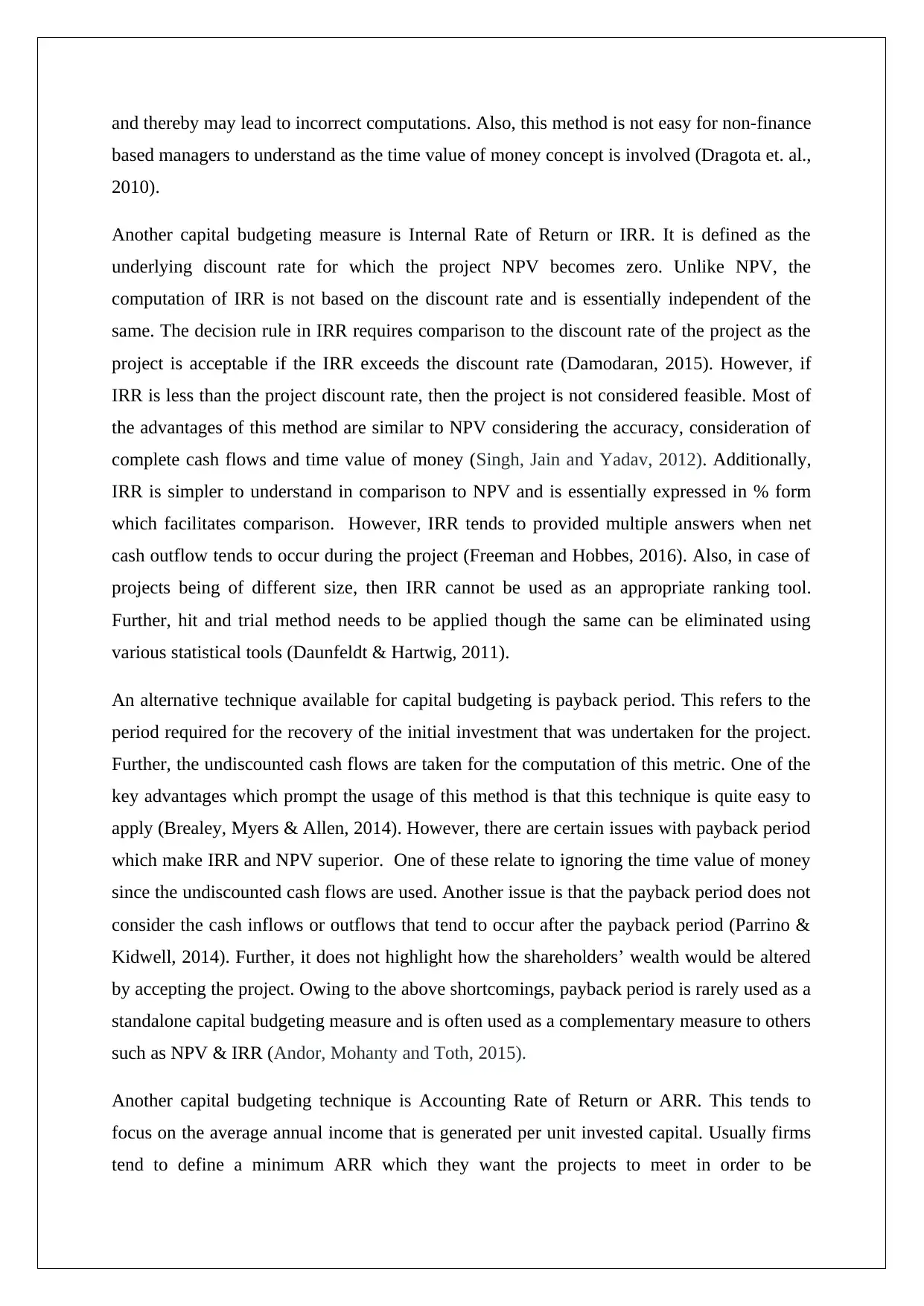
and thereby may lead to incorrect computations. Also, this method is not easy for non-finance
based managers to understand as the time value of money concept is involved (Dragota et. al.,
2010).
Another capital budgeting measure is Internal Rate of Return or IRR. It is defined as the
underlying discount rate for which the project NPV becomes zero. Unlike NPV, the
computation of IRR is not based on the discount rate and is essentially independent of the
same. The decision rule in IRR requires comparison to the discount rate of the project as the
project is acceptable if the IRR exceeds the discount rate (Damodaran, 2015). However, if
IRR is less than the project discount rate, then the project is not considered feasible. Most of
the advantages of this method are similar to NPV considering the accuracy, consideration of
complete cash flows and time value of money (Singh, Jain and Yadav, 2012). Additionally,
IRR is simpler to understand in comparison to NPV and is essentially expressed in % form
which facilitates comparison. However, IRR tends to provided multiple answers when net
cash outflow tends to occur during the project (Freeman and Hobbes, 2016). Also, in case of
projects being of different size, then IRR cannot be used as an appropriate ranking tool.
Further, hit and trial method needs to be applied though the same can be eliminated using
various statistical tools (Daunfeldt & Hartwig, 2011).
An alternative technique available for capital budgeting is payback period. This refers to the
period required for the recovery of the initial investment that was undertaken for the project.
Further, the undiscounted cash flows are taken for the computation of this metric. One of the
key advantages which prompt the usage of this method is that this technique is quite easy to
apply (Brealey, Myers & Allen, 2014). However, there are certain issues with payback period
which make IRR and NPV superior. One of these relate to ignoring the time value of money
since the undiscounted cash flows are used. Another issue is that the payback period does not
consider the cash inflows or outflows that tend to occur after the payback period (Parrino &
Kidwell, 2014). Further, it does not highlight how the shareholders’ wealth would be altered
by accepting the project. Owing to the above shortcomings, payback period is rarely used as a
standalone capital budgeting measure and is often used as a complementary measure to others
such as NPV & IRR (Andor, Mohanty and Toth, 2015).
Another capital budgeting technique is Accounting Rate of Return or ARR. This tends to
focus on the average annual income that is generated per unit invested capital. Usually firms
tend to define a minimum ARR which they want the projects to meet in order to be
based managers to understand as the time value of money concept is involved (Dragota et. al.,
2010).
Another capital budgeting measure is Internal Rate of Return or IRR. It is defined as the
underlying discount rate for which the project NPV becomes zero. Unlike NPV, the
computation of IRR is not based on the discount rate and is essentially independent of the
same. The decision rule in IRR requires comparison to the discount rate of the project as the
project is acceptable if the IRR exceeds the discount rate (Damodaran, 2015). However, if
IRR is less than the project discount rate, then the project is not considered feasible. Most of
the advantages of this method are similar to NPV considering the accuracy, consideration of
complete cash flows and time value of money (Singh, Jain and Yadav, 2012). Additionally,
IRR is simpler to understand in comparison to NPV and is essentially expressed in % form
which facilitates comparison. However, IRR tends to provided multiple answers when net
cash outflow tends to occur during the project (Freeman and Hobbes, 2016). Also, in case of
projects being of different size, then IRR cannot be used as an appropriate ranking tool.
Further, hit and trial method needs to be applied though the same can be eliminated using
various statistical tools (Daunfeldt & Hartwig, 2011).
An alternative technique available for capital budgeting is payback period. This refers to the
period required for the recovery of the initial investment that was undertaken for the project.
Further, the undiscounted cash flows are taken for the computation of this metric. One of the
key advantages which prompt the usage of this method is that this technique is quite easy to
apply (Brealey, Myers & Allen, 2014). However, there are certain issues with payback period
which make IRR and NPV superior. One of these relate to ignoring the time value of money
since the undiscounted cash flows are used. Another issue is that the payback period does not
consider the cash inflows or outflows that tend to occur after the payback period (Parrino &
Kidwell, 2014). Further, it does not highlight how the shareholders’ wealth would be altered
by accepting the project. Owing to the above shortcomings, payback period is rarely used as a
standalone capital budgeting measure and is often used as a complementary measure to others
such as NPV & IRR (Andor, Mohanty and Toth, 2015).
Another capital budgeting technique is Accounting Rate of Return or ARR. This tends to
focus on the average annual income that is generated per unit invested capital. Usually firms
tend to define a minimum ARR which they want the projects to meet in order to be
⊘ This is a preview!⊘
Do you want full access?
Subscribe today to unlock all pages.

Trusted by 1+ million students worldwide
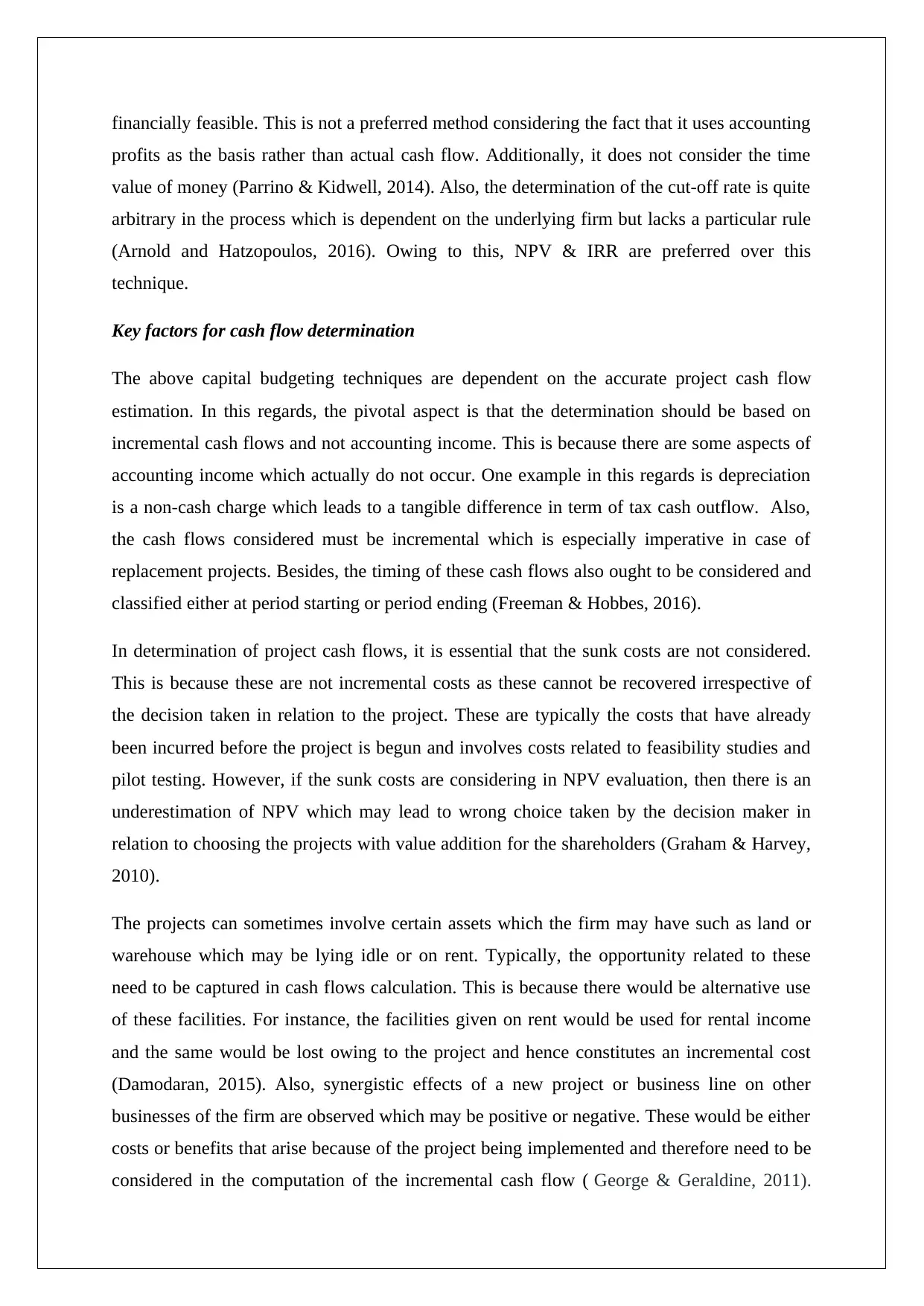
financially feasible. This is not a preferred method considering the fact that it uses accounting
profits as the basis rather than actual cash flow. Additionally, it does not consider the time
value of money (Parrino & Kidwell, 2014). Also, the determination of the cut-off rate is quite
arbitrary in the process which is dependent on the underlying firm but lacks a particular rule
(Arnold and Hatzopoulos, 2016). Owing to this, NPV & IRR are preferred over this
technique.
Key factors for cash flow determination
The above capital budgeting techniques are dependent on the accurate project cash flow
estimation. In this regards, the pivotal aspect is that the determination should be based on
incremental cash flows and not accounting income. This is because there are some aspects of
accounting income which actually do not occur. One example in this regards is depreciation
is a non-cash charge which leads to a tangible difference in term of tax cash outflow. Also,
the cash flows considered must be incremental which is especially imperative in case of
replacement projects. Besides, the timing of these cash flows also ought to be considered and
classified either at period starting or period ending (Freeman & Hobbes, 2016).
In determination of project cash flows, it is essential that the sunk costs are not considered.
This is because these are not incremental costs as these cannot be recovered irrespective of
the decision taken in relation to the project. These are typically the costs that have already
been incurred before the project is begun and involves costs related to feasibility studies and
pilot testing. However, if the sunk costs are considering in NPV evaluation, then there is an
underestimation of NPV which may lead to wrong choice taken by the decision maker in
relation to choosing the projects with value addition for the shareholders (Graham & Harvey,
2010).
The projects can sometimes involve certain assets which the firm may have such as land or
warehouse which may be lying idle or on rent. Typically, the opportunity related to these
need to be captured in cash flows calculation. This is because there would be alternative use
of these facilities. For instance, the facilities given on rent would be used for rental income
and the same would be lost owing to the project and hence constitutes an incremental cost
(Damodaran, 2015). Also, synergistic effects of a new project or business line on other
businesses of the firm are observed which may be positive or negative. These would be either
costs or benefits that arise because of the project being implemented and therefore need to be
considered in the computation of the incremental cash flow ( George & Geraldine, 2011).
profits as the basis rather than actual cash flow. Additionally, it does not consider the time
value of money (Parrino & Kidwell, 2014). Also, the determination of the cut-off rate is quite
arbitrary in the process which is dependent on the underlying firm but lacks a particular rule
(Arnold and Hatzopoulos, 2016). Owing to this, NPV & IRR are preferred over this
technique.
Key factors for cash flow determination
The above capital budgeting techniques are dependent on the accurate project cash flow
estimation. In this regards, the pivotal aspect is that the determination should be based on
incremental cash flows and not accounting income. This is because there are some aspects of
accounting income which actually do not occur. One example in this regards is depreciation
is a non-cash charge which leads to a tangible difference in term of tax cash outflow. Also,
the cash flows considered must be incremental which is especially imperative in case of
replacement projects. Besides, the timing of these cash flows also ought to be considered and
classified either at period starting or period ending (Freeman & Hobbes, 2016).
In determination of project cash flows, it is essential that the sunk costs are not considered.
This is because these are not incremental costs as these cannot be recovered irrespective of
the decision taken in relation to the project. These are typically the costs that have already
been incurred before the project is begun and involves costs related to feasibility studies and
pilot testing. However, if the sunk costs are considering in NPV evaluation, then there is an
underestimation of NPV which may lead to wrong choice taken by the decision maker in
relation to choosing the projects with value addition for the shareholders (Graham & Harvey,
2010).
The projects can sometimes involve certain assets which the firm may have such as land or
warehouse which may be lying idle or on rent. Typically, the opportunity related to these
need to be captured in cash flows calculation. This is because there would be alternative use
of these facilities. For instance, the facilities given on rent would be used for rental income
and the same would be lost owing to the project and hence constitutes an incremental cost
(Damodaran, 2015). Also, synergistic effects of a new project or business line on other
businesses of the firm are observed which may be positive or negative. These would be either
costs or benefits that arise because of the project being implemented and therefore need to be
considered in the computation of the incremental cash flow ( George & Geraldine, 2011).
Paraphrase This Document
Need a fresh take? Get an instant paraphrase of this document with our AI Paraphraser
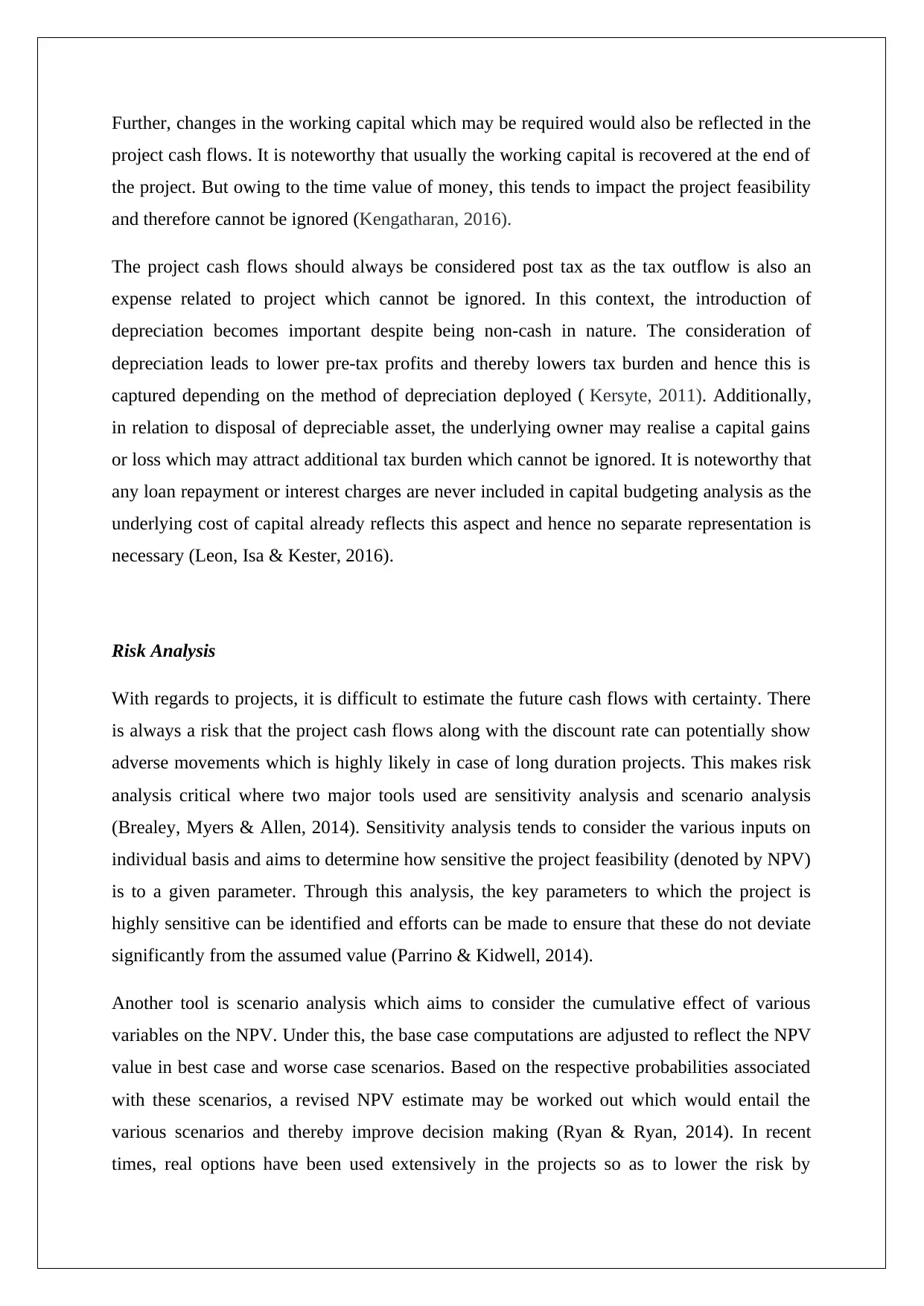
Further, changes in the working capital which may be required would also be reflected in the
project cash flows. It is noteworthy that usually the working capital is recovered at the end of
the project. But owing to the time value of money, this tends to impact the project feasibility
and therefore cannot be ignored (Kengatharan, 2016).
The project cash flows should always be considered post tax as the tax outflow is also an
expense related to project which cannot be ignored. In this context, the introduction of
depreciation becomes important despite being non-cash in nature. The consideration of
depreciation leads to lower pre-tax profits and thereby lowers tax burden and hence this is
captured depending on the method of depreciation deployed ( Kersyte, 2011). Additionally,
in relation to disposal of depreciable asset, the underlying owner may realise a capital gains
or loss which may attract additional tax burden which cannot be ignored. It is noteworthy that
any loan repayment or interest charges are never included in capital budgeting analysis as the
underlying cost of capital already reflects this aspect and hence no separate representation is
necessary (Leon, Isa & Kester, 2016).
Risk Analysis
With regards to projects, it is difficult to estimate the future cash flows with certainty. There
is always a risk that the project cash flows along with the discount rate can potentially show
adverse movements which is highly likely in case of long duration projects. This makes risk
analysis critical where two major tools used are sensitivity analysis and scenario analysis
(Brealey, Myers & Allen, 2014). Sensitivity analysis tends to consider the various inputs on
individual basis and aims to determine how sensitive the project feasibility (denoted by NPV)
is to a given parameter. Through this analysis, the key parameters to which the project is
highly sensitive can be identified and efforts can be made to ensure that these do not deviate
significantly from the assumed value (Parrino & Kidwell, 2014).
Another tool is scenario analysis which aims to consider the cumulative effect of various
variables on the NPV. Under this, the base case computations are adjusted to reflect the NPV
value in best case and worse case scenarios. Based on the respective probabilities associated
with these scenarios, a revised NPV estimate may be worked out which would entail the
various scenarios and thereby improve decision making (Ryan & Ryan, 2014). In recent
times, real options have been used extensively in the projects so as to lower the risk by
project cash flows. It is noteworthy that usually the working capital is recovered at the end of
the project. But owing to the time value of money, this tends to impact the project feasibility
and therefore cannot be ignored (Kengatharan, 2016).
The project cash flows should always be considered post tax as the tax outflow is also an
expense related to project which cannot be ignored. In this context, the introduction of
depreciation becomes important despite being non-cash in nature. The consideration of
depreciation leads to lower pre-tax profits and thereby lowers tax burden and hence this is
captured depending on the method of depreciation deployed ( Kersyte, 2011). Additionally,
in relation to disposal of depreciable asset, the underlying owner may realise a capital gains
or loss which may attract additional tax burden which cannot be ignored. It is noteworthy that
any loan repayment or interest charges are never included in capital budgeting analysis as the
underlying cost of capital already reflects this aspect and hence no separate representation is
necessary (Leon, Isa & Kester, 2016).
Risk Analysis
With regards to projects, it is difficult to estimate the future cash flows with certainty. There
is always a risk that the project cash flows along with the discount rate can potentially show
adverse movements which is highly likely in case of long duration projects. This makes risk
analysis critical where two major tools used are sensitivity analysis and scenario analysis
(Brealey, Myers & Allen, 2014). Sensitivity analysis tends to consider the various inputs on
individual basis and aims to determine how sensitive the project feasibility (denoted by NPV)
is to a given parameter. Through this analysis, the key parameters to which the project is
highly sensitive can be identified and efforts can be made to ensure that these do not deviate
significantly from the assumed value (Parrino & Kidwell, 2014).
Another tool is scenario analysis which aims to consider the cumulative effect of various
variables on the NPV. Under this, the base case computations are adjusted to reflect the NPV
value in best case and worse case scenarios. Based on the respective probabilities associated
with these scenarios, a revised NPV estimate may be worked out which would entail the
various scenarios and thereby improve decision making (Ryan & Ryan, 2014). In recent
times, real options have been used extensively in the projects so as to lower the risk by
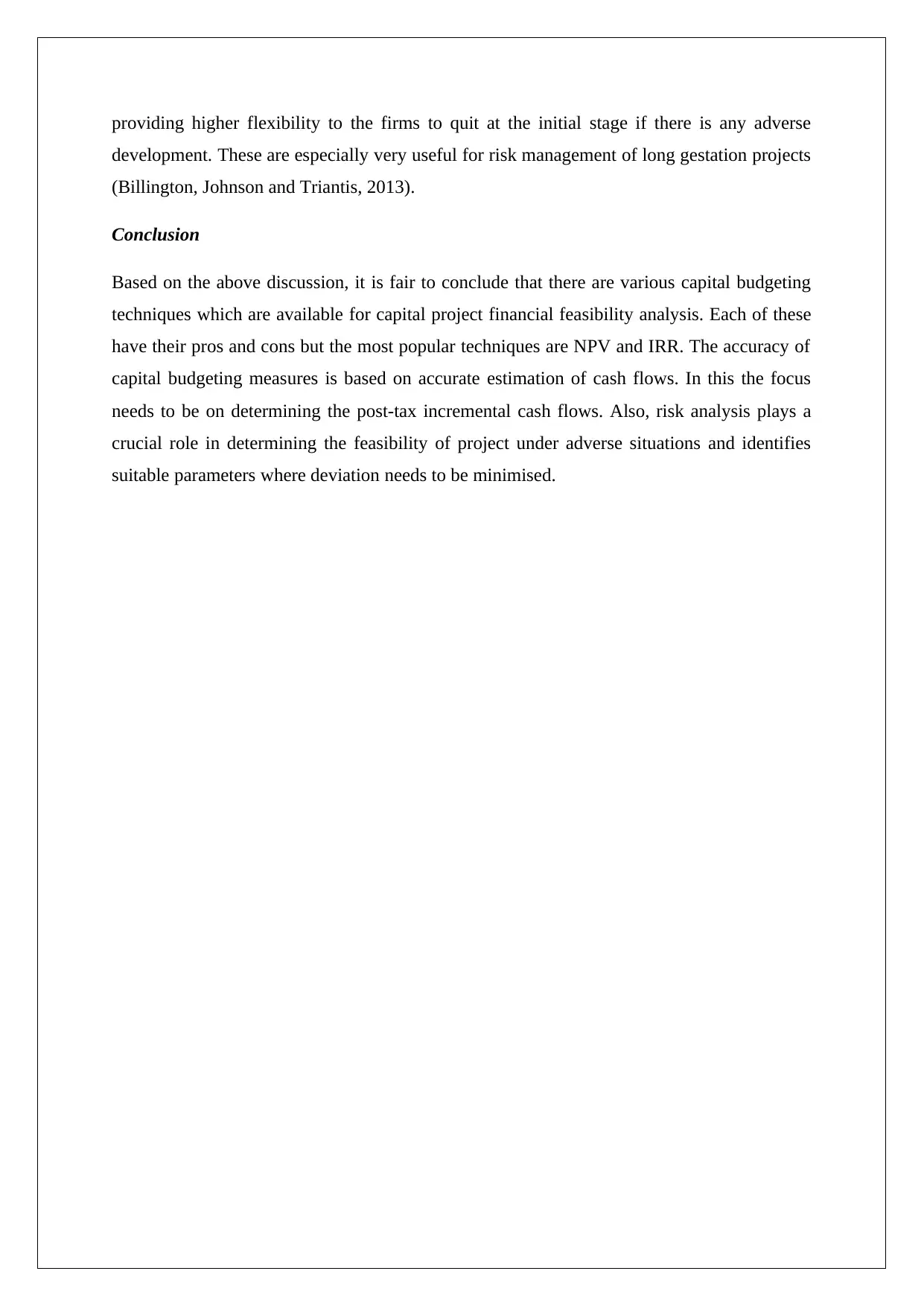
providing higher flexibility to the firms to quit at the initial stage if there is any adverse
development. These are especially very useful for risk management of long gestation projects
(Billington, Johnson and Triantis, 2013).
Conclusion
Based on the above discussion, it is fair to conclude that there are various capital budgeting
techniques which are available for capital project financial feasibility analysis. Each of these
have their pros and cons but the most popular techniques are NPV and IRR. The accuracy of
capital budgeting measures is based on accurate estimation of cash flows. In this the focus
needs to be on determining the post-tax incremental cash flows. Also, risk analysis plays a
crucial role in determining the feasibility of project under adverse situations and identifies
suitable parameters where deviation needs to be minimised.
development. These are especially very useful for risk management of long gestation projects
(Billington, Johnson and Triantis, 2013).
Conclusion
Based on the above discussion, it is fair to conclude that there are various capital budgeting
techniques which are available for capital project financial feasibility analysis. Each of these
have their pros and cons but the most popular techniques are NPV and IRR. The accuracy of
capital budgeting measures is based on accurate estimation of cash flows. In this the focus
needs to be on determining the post-tax incremental cash flows. Also, risk analysis plays a
crucial role in determining the feasibility of project under adverse situations and identifies
suitable parameters where deviation needs to be minimised.
⊘ This is a preview!⊘
Do you want full access?
Subscribe today to unlock all pages.

Trusted by 1+ million students worldwide
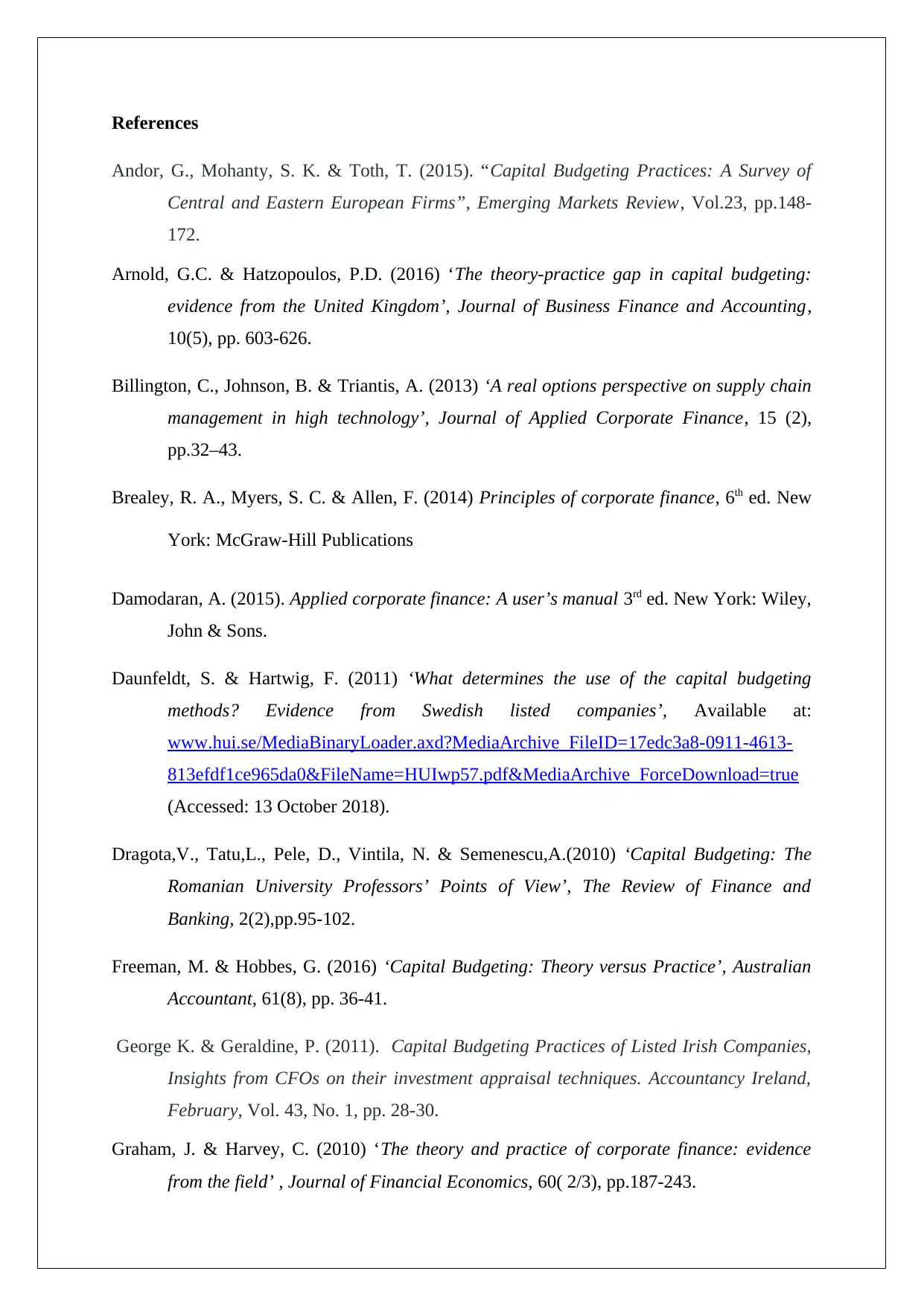
References
Andor, G., Mohanty, S. K. & Toth, T. (2015). “Capital Budgeting Practices: A Survey of
Central and Eastern European Firms”, Emerging Markets Review, Vol.23, pp.148-
172.
Arnold, G.C. & Hatzopoulos, P.D. (2016) ‘The theory-practice gap in capital budgeting:
evidence from the United Kingdom’, Journal of Business Finance and Accounting,
10(5), pp. 603-626.
Billington, C., Johnson, B. & Triantis, A. (2013) ‘A real options perspective on supply chain
management in high technology’, Journal of Applied Corporate Finance, 15 (2),
pp.32–43.
Brealey, R. A., Myers, S. C. & Allen, F. (2014) Principles of corporate finance, 6th ed. New
York: McGraw-Hill Publications
Damodaran, A. (2015). Applied corporate finance: A user’s manual 3rd ed. New York: Wiley,
John & Sons.
Daunfeldt, S. & Hartwig, F. (2011) ‘What determines the use of the capital budgeting
methods? Evidence from Swedish listed companies’, Available at:
www.hui.se/MediaBinaryLoader.axd?MediaArchive_FileID=17edc3a8-0911-4613-
813efdf1ce965da0&FileName=HUIwp57.pdf&MediaArchive_ForceDownload=true
(Accessed: 13 October 2018).
Dragota,V., Tatu,L., Pele, D., Vintila, N. & Semenescu,A.(2010) ‘Capital Budgeting: The
Romanian University Professors’ Points of View’, The Review of Finance and
Banking, 2(2),pp.95-102.
Freeman, M. & Hobbes, G. (2016) ‘Capital Budgeting: Theory versus Practice’, Australian
Accountant, 61(8), pp. 36-41.
George K. & Geraldine, P. (2011). Capital Budgeting Practices of Listed Irish Companies,
Insights from CFOs on their investment appraisal techniques. Accountancy Ireland,
February, Vol. 43, No. 1, pp. 28-30.
Graham, J. & Harvey, C. (2010) ‘The theory and practice of corporate finance: evidence
from the field’ , Journal of Financial Economics, 60( 2/3), pp.187-243.
Andor, G., Mohanty, S. K. & Toth, T. (2015). “Capital Budgeting Practices: A Survey of
Central and Eastern European Firms”, Emerging Markets Review, Vol.23, pp.148-
172.
Arnold, G.C. & Hatzopoulos, P.D. (2016) ‘The theory-practice gap in capital budgeting:
evidence from the United Kingdom’, Journal of Business Finance and Accounting,
10(5), pp. 603-626.
Billington, C., Johnson, B. & Triantis, A. (2013) ‘A real options perspective on supply chain
management in high technology’, Journal of Applied Corporate Finance, 15 (2),
pp.32–43.
Brealey, R. A., Myers, S. C. & Allen, F. (2014) Principles of corporate finance, 6th ed. New
York: McGraw-Hill Publications
Damodaran, A. (2015). Applied corporate finance: A user’s manual 3rd ed. New York: Wiley,
John & Sons.
Daunfeldt, S. & Hartwig, F. (2011) ‘What determines the use of the capital budgeting
methods? Evidence from Swedish listed companies’, Available at:
www.hui.se/MediaBinaryLoader.axd?MediaArchive_FileID=17edc3a8-0911-4613-
813efdf1ce965da0&FileName=HUIwp57.pdf&MediaArchive_ForceDownload=true
(Accessed: 13 October 2018).
Dragota,V., Tatu,L., Pele, D., Vintila, N. & Semenescu,A.(2010) ‘Capital Budgeting: The
Romanian University Professors’ Points of View’, The Review of Finance and
Banking, 2(2),pp.95-102.
Freeman, M. & Hobbes, G. (2016) ‘Capital Budgeting: Theory versus Practice’, Australian
Accountant, 61(8), pp. 36-41.
George K. & Geraldine, P. (2011). Capital Budgeting Practices of Listed Irish Companies,
Insights from CFOs on their investment appraisal techniques. Accountancy Ireland,
February, Vol. 43, No. 1, pp. 28-30.
Graham, J. & Harvey, C. (2010) ‘The theory and practice of corporate finance: evidence
from the field’ , Journal of Financial Economics, 60( 2/3), pp.187-243.
Paraphrase This Document
Need a fresh take? Get an instant paraphrase of this document with our AI Paraphraser
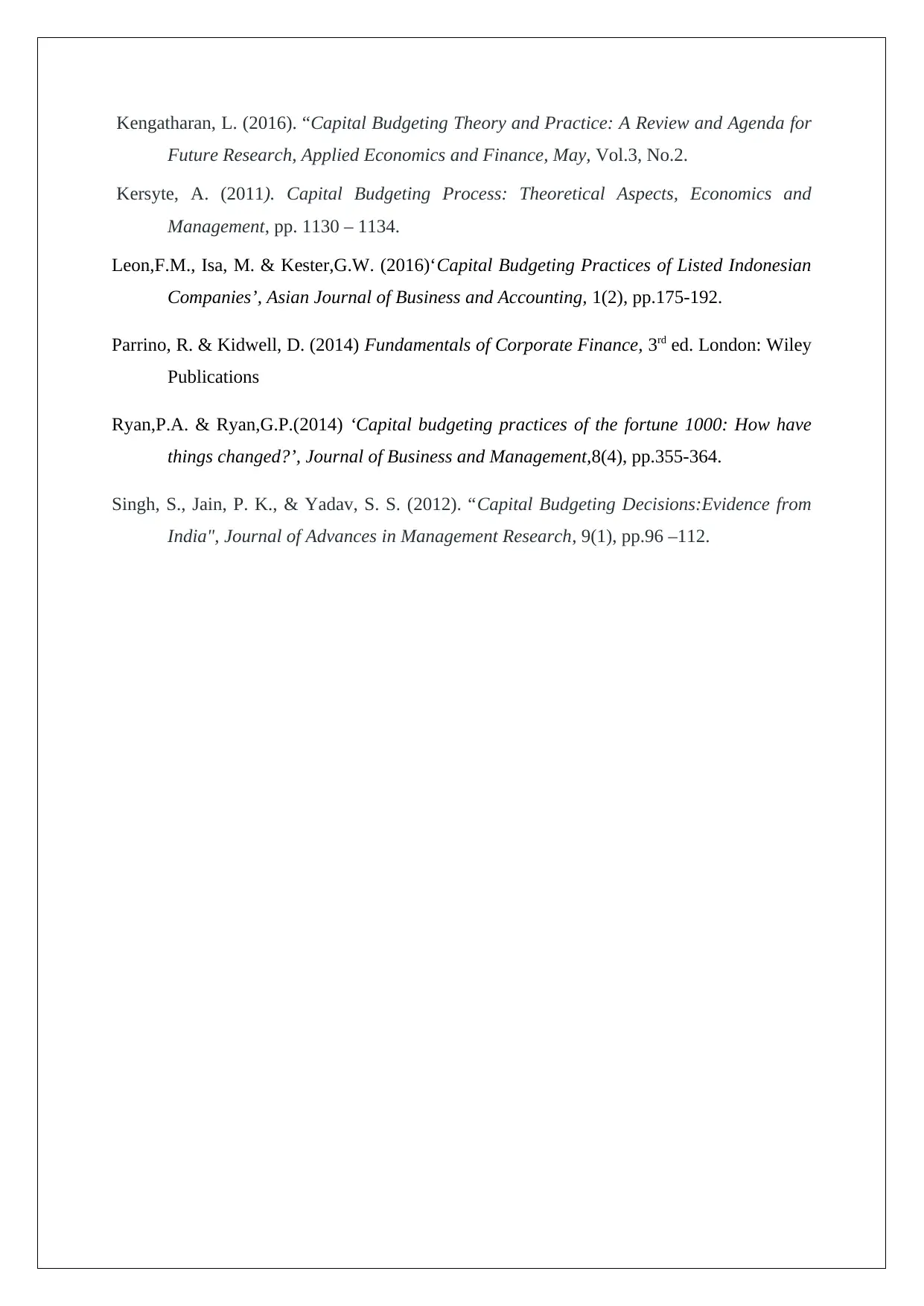
Kengatharan, L. (2016). “Capital Budgeting Theory and Practice: A Review and Agenda for
Future Research, Applied Economics and Finance, May, Vol.3, No.2.
Kersyte, A. (2011). Capital Budgeting Process: Theoretical Aspects, Economics and
Management, pp. 1130 – 1134.
Leon,F.M., Isa, M. & Kester,G.W. (2016)‘Capital Budgeting Practices of Listed Indonesian
Companies’, Asian Journal of Business and Accounting, 1(2), pp.175-192.
Parrino, R. & Kidwell, D. (2014) Fundamentals of Corporate Finance, 3rd ed. London: Wiley
Publications
Ryan,P.A. & Ryan,G.P.(2014) ‘Capital budgeting practices of the fortune 1000: How have
things changed?’, Journal of Business and Management,8(4), pp.355-364.
Singh, S., Jain, P. K., & Yadav, S. S. (2012). “Capital Budgeting Decisions:Evidence from
India", Journal of Advances in Management Research, 9(1), pp.96 –112.
Future Research, Applied Economics and Finance, May, Vol.3, No.2.
Kersyte, A. (2011). Capital Budgeting Process: Theoretical Aspects, Economics and
Management, pp. 1130 – 1134.
Leon,F.M., Isa, M. & Kester,G.W. (2016)‘Capital Budgeting Practices of Listed Indonesian
Companies’, Asian Journal of Business and Accounting, 1(2), pp.175-192.
Parrino, R. & Kidwell, D. (2014) Fundamentals of Corporate Finance, 3rd ed. London: Wiley
Publications
Ryan,P.A. & Ryan,G.P.(2014) ‘Capital budgeting practices of the fortune 1000: How have
things changed?’, Journal of Business and Management,8(4), pp.355-364.
Singh, S., Jain, P. K., & Yadav, S. S. (2012). “Capital Budgeting Decisions:Evidence from
India", Journal of Advances in Management Research, 9(1), pp.96 –112.
1 out of 8
Related Documents
Your All-in-One AI-Powered Toolkit for Academic Success.
+13062052269
info@desklib.com
Available 24*7 on WhatsApp / Email
![[object Object]](/_next/static/media/star-bottom.7253800d.svg)
Unlock your academic potential
Copyright © 2020–2025 A2Z Services. All Rights Reserved. Developed and managed by ZUCOL.





